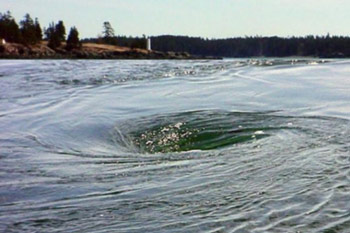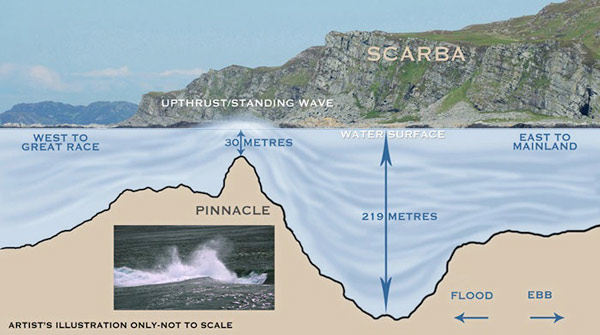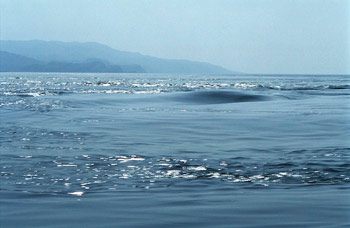The Old Sow
Maine’s Legendary Monster Whirlpool
by Tom Seymour

The Old Sow looking east toward Deer Island Point, New Brunswick, Canada about 500 feet in the background. The largest whirlpool in the western hemisphere it is in the Western Passage between Deer Island, Canada and about 1500 feet east of Moose Island, Eastport, Maine. The size, speed and location varies with the height of tides.
Lured by reports of plentiful cod, my buddy and I took off for Eastport, hauling his 20-foot fiberglass inboard runabout. As it turned out, fishing was not easy because of the great depth and raging tides. We didn’t catch a single cod. We did, however catch some huge, as in 3-pound, mackerel.
What made the trip memorable wasn’t the lack of cod or the huge mackerel but rather, an unexpected merry-go-round ride we took on a 50-foot diameter whirlpool, or “tide bore,” as many refer to whirlpools.
Motoring along we spotted troubled water, boiling and swirling. While I wanted to stay clear, my pal was in control and we headed for the whirlpool. Prudence would have dictated that this was a foolish, senseless act, but providence saw to it that the whirlpool was not at its fiendish worst. Instead of the open mouth of a bottomless vortex, the whirlpool at the time was tame.
So our boat went around and around and when my pal tired of this, he finally harkened to my pleas and left the area. Thankfully the motor ran well and we suffered no complications.
Was this the Old Sow, Maine’s infamous whirlpool? Or was it one of the “piglets,” smaller whirlpools spawned by the same forces that propelled the Old Sow? It’s hard to say. Whirlpools aren’t marked by signage and as far as people in small vessels, one big whirlpool seems as fearsome as another. And regarding the Old Sow, rightly so, since it is the biggest whirlpool in the western hemisphere and the second largest in the entire world.
Located in the 1/2 mile wideWestern Passage, between Deer Island Point, New Brunswick, Canada and Moose Island, Eastport, Maine. At the edge of the Bay of Fundy, the area is subject to the highest tidal ranges in the world.
It wasn’t until years after our adventure that I learned that the Old Sow has claimed a list of victims. One of the earliest recorded human losses occurred in 1835 when Abner and Robert Norwood set out on their two-masted schooner Quickstep.
The young men’s mother watched from shore as a sudden squall hit the water, bringing driving rain and harsh winds. And the wind began driving the Quickstep in a direction the men didn’t want to go and that was directly toward the Old Sow.
At first, according to a period account, the whirlpool seemed tame, with a silky but undulating surface. And then as their vessel was pushed ever closer, the Old Sow came to life. As the Quickstep began spinning, caught in the grip of the ever-growing whirlpool, a hole opened up in the Old Sow’s middle.
As the Old Sow tightened its grip on the Quickstep, Abner lost steerage because now the stern was completely out of water as the ship continued to spin on its way down to eternity and the rudder hung useless in the air.
Modern readers can only imagine the angst, fear and unmitigated terror the mother must have felt, watching her only two offspring disappear into the maws of the fiendish, Old Sow Whirlpool.
And then, unable to withstand the forces of nature hurling her around, the Quickstep was shattered, exploding into countless bits. Not even the tiniest scrap of the doomed vessel was ever found. Abner was never seen again, while a single account from the time suggested that Robert was recovered alive, clinging to an oar.

The contour of the bottom and distance between adjacent land masses determine whether a whirlpool will form and its intensity. This graphic describes the topography under a whirlpool off the central west coast of Scotland. In the narrow Gulf of Corryvreckan between the islands of Scarba and Jura, flood tides create large standing waves and whirlpools.
Other Victims
While historical accounts of human losses attributable to the Old Sow underscore past and present dangers of straying too close to the big whirlpool or even some of the smaller ones that continually appear in the area, written reports most likely fail to account for the sum total of losses over the many years.
But still, existing accounts present a picture that couldn’t be much more frightening. For instance, in the late 1800s, two men on a barge loaded with logs were unable to turn their heavy, sulking craft away from an encounter with the Old Sow. The barge, its cargo of logs and the men vanished, none were ever seen again.
Then we have the very brief account of Cecil Chaffee, who, in 1912 was rowing out in the bay and found himself being pulled into the Old Sow. Chaffee was unable to save himself and drowned as he was pulled into the Old Sow.
And in 1944, James Roland Mitchell was sailing on the bay when his vessel’s boom swung around, knocking Mitchell into the water. This occurred very near the Old Sow. And like Cecil Chaffee, James Roland Mitchell found the forces of the currents of the huge whirlpool too strong to resist and he drowned.
Also in the 1940s, a freighter hauling sardines from Lubec, Maine to St. Andrews, New Brunswick, found itself on top of the Old Sow. A huge funnel appeared beneath the bow and the vessel began dropping into the hole thus formed. With the propeller high and dry out of the water, the vessel lost all steering. And as suddenly as the incident had occurred, the propeller became immersed and steering was returned. The skipper then managed to work the vessel out of the jaws of the Old Sow, a some would say, miraculous occurrence.
The Old Sow continues to claim victims to this day. In 1995, a Deer Island fishing boat, the 55-foot Fundy Star II became trapped in a cross-current and rolled over in the Old Sow. Another boat was in the vicinity and quickly came to the rescue, saving the three crew members from an uncertain fate.
Not long after the Fundy Star incident, a pair of kayakers, a husband-and-wife team, ventured too close to the Old Sow and were caught in its whirling currents. The husband managed to escape the sow’s grip, but his wife continued to spin around and around until rescue finally arrived.
And finally, in December 2009, two recreational divers ventured too close to the Old Sow. One was able to swim away and eventually reached the Coast Guard, which came to the rescue of the other diver, but by the time they reached the scene, the stricken diver managed to break free and swim to shore.
While that was the last incident of note regarding the Old Sow and people and their vessels, it will doubtless not be the last.
Unique Situation

Standing wave created by currents upwelling over an obstruction. A likely origin of sow is the word “sough” (pronounced “suff”), defined as a “drain,” or a “sucking sound.” Early settlers to the area may easily have mispronounced “sough,” as “sow” (rhyming with “cow”) due to its similar spelling to other words with “sow-sound” endings, such as “plough.”
The Old Sow and other nearby whirlpools owe their being to the great tidal range where waters flow between Passamaquoddy Bay and the Bay of Fundy. This, coupled with a diverse and contrasting ocean bottom, create an ideal situation for whirlpools with each change of tide.
An aerial photograph, taken in 1997 used the Deer Island Point Light beacon tower as a known entity of a confirmed width. This served to show that the area where whirlpools form is approximately 250 feet in diameter.
Today’s motorized vessels are unlikely to suffer harm from whirlpools in the area of the Old Sow. But even so, accidents can occur. However, sail and human-powered vessels (consider the recent case of the two kayakers) remain at high risk and those in such vehicles are warned to avoid the area during a running tide.
Besides the smaller whirlpools surrounding the Old Sow, other oddball phenomenon often appear in the area. These include standing waves, called “upwellings,” which may leap as high as two or three feet in the air and depressions on the water’s surface that can range between 10 and 17-feet deep.
Even today, the waters of Passamaquoddy Bay and the Bay of Fundy command our highest degree of respect. Vessels of varying sizes continue to, inadvertently, pass over the Old Sow and its contingent whirlpools. People venturing out on otherwise calm water instantly find themselves in deep troughs, a very dangerous situation. No one knows when some vessel will become disabled in the vicinity of the Old Sow and become entrapped in the whirlpool’s unyielding grip. It has happened many times before and chances are that some day in the future it will happen again.
